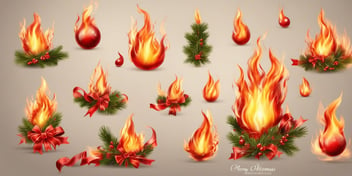- Blog
- Christmas tree
- Preventing Christmas Tree Fires: Essential Safety Measures

Christmas is a time of joy, laughter, and cozy gatherings. As we deck the halls and embrace the twinkling lights of our majestic trees, it's essential to remember the importance of safety measures to protect our homes and loved ones. While the warmth and beauty of a Christmas tree bring us comfort, the last thing anybody wants is for it to become a blazing inferno.
So, before you gather 'round the fire for another round of carols, let's explore some essential safety measures to prevent Christmas tree fires. 'Tis the season to stay safe!
Preventing Christmas Tree Fires: Essential Safety Measures
To prevent a Christmas tree fire, taking essential safety measures is crucial. One vital step is to choose the right tree. Opt for a fresh tree that has green needles that don't easily break. When setting up the tree, ensure it is positioned safely away from heat sources like radiators or fireplaces. Decorating the tree should be done using safe lighting, such as LED lights, to avoid electrical hazards.
Additionally, keep flammable decorations and candles away from the tree. Regularly watering the tree and turning off lights at night are simple yet effective fire prevention practices.
Finally, having a fire safety plan in place, including knowing the location of fire extinguishers and having an evacuation plan, is essential.
Why Christmas Tree Fires Are a Concern
The Statistics
The statistics regarding Christmas tree fires are alarming. According to the National Fire Protection Association, between 2014 and 2018, U.S. fire departments responded to an average of 160 home fires annually that started with a Christmas tree. These fires resulted in an average of three deaths, 15 injuries, and $10 million in direct property damage each year.
The majority of these incidents occurred in December, with the peak happening during the week of Christmas. A common cause of these fires is electrical distribution or lighting equipment. This highlights the need for proper precautions when setting up and decorating your Christmas tree to prevent devastating accidents.
The Dangers of Christmas Tree Fires
- A Christmas tree on fire can quickly escalate into a dangerous situation.
- The flames can spread rapidly throughout your home, causing significant damage.
- The heat generated can ignite nearby furniture, curtains, and other flammable items.
- Thick smoke can fill your home, making it difficult to see and breathe.
- Inhaling smoke can lead to respiratory issues and even loss of consciousness.
- The intense heat can cause structural damage and weaken the integrity of your home.
- The combination of fire, smoke, and heat poses a serious threat to the safety and well-being of your family and pets.
Remember, taking necessary precautions and implementing safety measures can greatly reduce the risk of a Christmas tree fire.
Choosing the Right Christmas Tree
Natural vs. Artificial Trees
- Natural trees pose a higher fire risk compared to artificial ones.
- Natural trees can dry out and become flammable if not properly cared for.
- Artificial trees are often made of fire-resistant materials, reducing the risk of flames spreading.
- Choosing a natural tree? Opt for a freshly cut one and keep it hydrated by regularly watering it.
- Artificial trees are generally considered safer, but ensure they are labeled as fire-resistant.
- Whichever type you choose, always keep the tree a safe distance away from heat sources and open flames.
Selecting a Fresh Tree
When selecting a fresh Christmas tree, it is important to consider fire safety. Here are some tips to help you choose a fresh tree that is less likely to catch fire:
- Look for vibrant green needles that are firmly attached to the branches.
- Gently shake the tree to see if excessive needles fall off, as dried-out trees are more flammable.
- Check for a strong pine scent, indicating freshness.
- Avoid trees with dry or brittle branches, as they pose a higher fire risk.
- Consider purchasing a tree with a root ball, as these have better moisture retention.
By selecting a fresh tree, you can minimize the risk of a Christmas tree on fire and ensure a safer holiday season.
Ensuring Proper Tree Size
- Choose a Christmas tree that fits well in your designated space to reduce the risk of fire.
- A tree that is too large can pose a greater fire hazard as it may come into contact with heat sources such as candles or heating vents.
- Measure the height and width of the area where the tree will be placed to determine the maximum size you should go for.
- Consider the distance between the tree and other objects like furniture, curtains, or decorations.
- Remember to account for the height of the tree stand or any additional toppers or ornaments that may increase its overall height.
- Proper tree sizing is a crucial aspect of preventing a Christmas tree fire.
Setting Up Your Christmas Tree
Positioning the Tree Safely
Positioning your Christmas tree safely is crucial to minimize the risk of a fire. Avoid placing it near heat sources such as fireplaces, radiators, or heating vents. Make sure the tree is at least three feet away from any potential ignition sources.
Additionally, keep it clear of exits and pathways to ensure a safe escape route in case of a fire. By positioning your tree strategically and maintaining proper clearance, you can significantly reduce the chances of a devastating Christmas tree fire. Remember to always prioritize safety when choosing the location for your tree.
Inspecting and Preparing the Tree
Before decorating, carefully inspect the Christmas tree for any signs of damage or dryness. Look for loose or broken branches that could pose a fire hazard. Additionally, check the needles for brittleness or excessive shedding. To ensure a safe tree, give it a gentle shake – if a large number of needles fall off, it may be too dry and prone to catching fire. Remember to trim the trunk by about two inches to improve water absorption and keep the tree hydrated. Taking these precautions reduces the risk of a Christmas tree fire.
Stabilizing the Tree
To prevent a Christmas tree fire, ensuring the stability of the tree is important. A wobbly tree increases the risk of it tipping over, potentially igniting nearby flammable items. Use a sturdy tree stand suited for the size of your tree, securing it properly. For added stability, consider using additional support options like tying the tree to nearby furniture or attaching it to the wall. If you have pets or small children, make sure the tree is out of their reach to minimize the chance of accidental knockdowns. Taking these precautions can significantly reduce the chances of a Christmas tree fire and ensure a safe holiday season.
Decorating Your Christmas Tree
Using Safe Lighting
When it comes to preventing a Christmas tree on fire, using safe lighting is crucial. Here's how to ensure a safe festive display:
- Avoid using damaged or frayed wiring for your Christmas lights.
- Opt for LED lights as they produce less heat and lower the risk of fire.
- Make sure the lights have been tested and certified for safety.
- Don't overload electrical outlets or use extension cords excessively.
- Turn off the lights when leaving the house or going to bed.
- Keep an eye on the lights for any signs of overheating or malfunctioning.
Avoiding Damaged or Frayed Wiring
When it comes to preventing a Christmas tree on fire, avoiding damaged or frayed wiring is vital. Faulty electrical connections can easily ignite a tree and escalate into a dangerous fire. Inspect all light strings and electrical cords for any signs of wear or damage, such as frayed wires or exposed metal. Replace any faulty or damaged cords immediately to minimize the risk of fire.
Additionally, make sure not to overload electrical outlets and use surge protectors to prevent electrical failures. Remember, proactive measures like checking and replacing damaged wiring can significantly reduce the chances of a Christmas tree fire. Stay safe this holiday season.
Choosing LED Lights
When it comes to preventing a Christmas tree fire, choosing LED lights is a wise decision. LED lights generate less heat compared to traditional incandescent lights, reducing the risk of fire. Their cool operation greatly minimizes the chances of the tree drying out and becoming a fire hazard.
Additionally, LED lights are more durable and have a longer lifespan, providing a reliable and safer lighting option. By opting for LED lights, you can enjoy the festive ambiance without compromising on safety.
Avoiding Flammable Decorations
When decorating your Christmas tree, it is crucial to avoid using flammable decorations that can ignite easily. Choose decorations made from non-combustible materials such as glass, metal, or fire-resistant materials. Avoid using paper, fabric, or other highly flammable items. Opt for LED lights instead of traditional incandescent lights, as they emit less heat and reduce the risk of fire. Additionally, keep candles away from the tree to prevent accidental ignition. Remember, it's safer to prioritize the use of fire-resistant and non-flammable decorations to keep your Christmas tree from turning into a potential fire hazard.
Keeping Candles Away
Keeping candles away from your Christmas tree is a vital safety precaution. Even though candles add a cozy ambiance, they can easily ignite the tree's flammable branches and decorations, leading to a dangerous fire. Opt for flameless LED candles instead, which provide a similar flickering glow without the risk of an open flame. If you prefer traditional candles, make sure they are placed in sturdy, non-flammable holders far away from the tree and any other combustible materials.
Always rememberto never leave lit candles unattended, especially in the presence of a Christmas tree. Safety should be the top priority when it comes to candle usage during the holiday season.
Fire Prevention Tips for a Safe Christmas
Placing the Tree Away from Heat Sources
Place your Christmas tree at a safe distance from heat sources to minimize the risk of a fire. Keep it away from heaters, radiators, fireplaces, candles, and other open flames. Direct contact with heat can dry out the tree, making it more susceptible to catching fire easily. Ensure that there is enough space between the tree and any heat-generating objects. If you have a fireplace, make sure the tree is positioned at a safe distance from it.
By maintaining adequate separation from heat sources,you can significantly reduce the likelihood of a Christmas tree fire.
Regularly Watering the Tree
Regularly watering your Christmas tree is vital in minimizing the risk of a Christmas tree fire. Here's why:
- A well-hydrated tree is less likely to ignite and burn rapidly compared to a dry tree.
- Dry needles can easily catch fire from nearby heat sources, such as candles or faulty wiring.
- Watering your tree helps maintain its moisture, preventing it from drying out and becoming a potential fire hazard.
To ensure your tree stays hydrated:
- Check the water level daily and add water as needed.
- Use a tree stand with a water reservoir for easier watering.
Remember, keeping your Christmas tree hydrated throughout the holiday season is a simple yet effective way to protect your home and loved ones from the danger of a Christmas tree fire.
Turning Off Lights at Night
Turning off the lights at night is a simple yet effective measure to prevent Christmas tree fires. When the lights are left unattended, the risk of overheating and electrical malfunctions increases, potentially igniting the tree. By switching off the lights before going to bed or leaving the house, you eliminate the chances of a fire breaking out while everyone is asleep or away.
Additionally, consider using a timer or smart plug to automatically turn the lights off at a designated time. This way, you can enjoy the festive ambiance while ensuring the safety of your home and loved ones.
Christmas Tree Fire Safety Plan
Locating Fire Extinguishers
- Place fire extinguishers strategically in your home, close to the area where the Christmas tree is positioned.
- Keep one within reach, such as in the same room or nearby hallway, to quickly access it in case of a fire.
- Install fire extinguishers on each floor of your home, ensuring they are easily visible and not hidden behind furniture or other objects.
- Consider placing a multipurpose fire extinguisher near the tree, capable of extinguishing different types of fires, including electrical fires.
- Regularly check the expiration dates on your fire extinguishers and ensure they are in good working condition.
Having an Evacuation Plan
Having an evacuation plan is crucial in the event of a Christmas tree on fire. Make sure everyone in your household knows the fastest and safest way to exit the house. Identify multiple escape routes and designate a meeting point outside. Practice the plan regularly, especially if you have young children. Consider installing smoke detectors in every bedroom and on every floor of your home to alert you to the presence of smoke.
Teach your family how to crawl low under the smoke and emphasize theimportance of not going back inside for any reason.
Testing Smoke Alarms
Testing smoke alarms regularly is vital in ensuring your family's safety in the event of a Christmas tree fire. Smoke alarms act as an early warning system, alerting you to the presence of smoke or fire. Make it a habit to test your smoke alarms monthly by pressing the test button. Check if the alarm emits a loud, audible sound throughout your home. If the sound is weak or nonexistent, replace the batteries immediately.
Additionally, clean the alarms regularly to remove any dust or debris that may impair their functionality. Remember, having properly functioning smoke alarms can help provide precious time to escape in case of an emergency.
What to Do If Your Christmas Tree Catches Fire
Stay Calm and Act Quickly
In the event of a Christmas tree catching fire, it is crucial to remain calm and act swiftly. Panic can hinder your ability to respond effectively. Begin by ensuring the safety of everyone present, guiding them to a predetermined evacuation point. If the fire is small and manageable, use a fire extinguisher to extinguish it, aiming at the base of the flames. However, do not attempt to fight the fire if it grows rapidly or becomes uncontrollable. Instead, evacuate immediately and call emergency services. Remember, your primary concern should always be the safety of yourself and others.
Using a Fire Extinguisher
- Remember the acronym PASS: Pull the pin, Aim at the base of the flames, Squeeze the handle, Sweep from side to side.
- Stand a safe distance from the fire while aiming at the base.
- Avoid using water on an electrical fire as it can increase the risk of electrocution.
- Use a multipurpose fire extinguisher suitable for both Class A (wood, paper) and Class B (flammable liquids) fires.
- If the fire becomes too large to handle or you are unsure, evacuate and call emergency services immediately.
- Regularly check the expiration date and ensure the fire extinguisher is easily accessible near the Christmas tree.
Evacuating Safely
Evacuating safely is of utmost importance when faced with a Christmas tree on fire. Remember to stay calm and quickly gather all occupants in the house to a designated meeting point outside. Avoid using elevators and use the nearest exit, keeping low to the ground to avoid smoke inhalation. If necessary, use a wet cloth to cover your mouth and nose. Ensure everyone is accounted for and call emergency services immediately.
It is crucial to practice fire drills with your family to ensure a smoothand efficient evacuation in case of an emergency.
Calling Emergency Services
- If your Christmas tree catches fire, it's important to act quickly and call emergency services immediately.
- Dial the emergency number in your country (e.g., 911 in the United States) to report the fire.
- Stay on the line and provide clear and concise information about the situation. Mention that your Christmas tree is on fire and provide your address or location.
- Follow any instructions given by the emergency operator and stay on the line until they tell you it's safe to hang up.
- Do not attempt to fight the fire alone unless you have received proper training and have an appropriate extinguisher available.
- Evacuate the area and wait for the fire department to arrive.
Summary
Christmas tree fires can be dangerous and devastating, but there are essential safety measures that can help prevent them. First and foremost, it is crucial to choose a fresh tree and keep it well-watered throughout the holiday season. Placing the tree away from heat sources such as fireplaces, radiators, or candles is also important. Using LED lights instead of traditional incandescent bulbs can significantly reduce the risk of fire.
Additionally, inspecting lights and cords for any damage or wear, and avoiding overloading electrical outlets are crucial steps to minimize potential fire hazards. Regularly turning off the tree lights when unattended or going to bed is a smart safety practice. Lastly, promptly disposing of the tree once it becomes dry and brittle is essential to prevent further fire risks. By following these safety measures, we can enjoy the beauty of a Christmas tree without compromising our safety.
Read On

Stay Safe this Holiday Season: How to Prevent Christmas Tree Fire Hazards
The holiday season is filled with twinkling lights, joyful carols, and the delightful aroma of...

From Pine to Perfection: Mastering Christmas Tree Care and Maintenance
Ah, the holiday season is upon us - a time for festive decorations, merry gatherings, and of...

Creating a Cozy Ambiance: How to Use Candles on Christmas Trees
Picture this: it's Christmas Eve, and you're snuggled up on the couch, gazing at the twinkling...